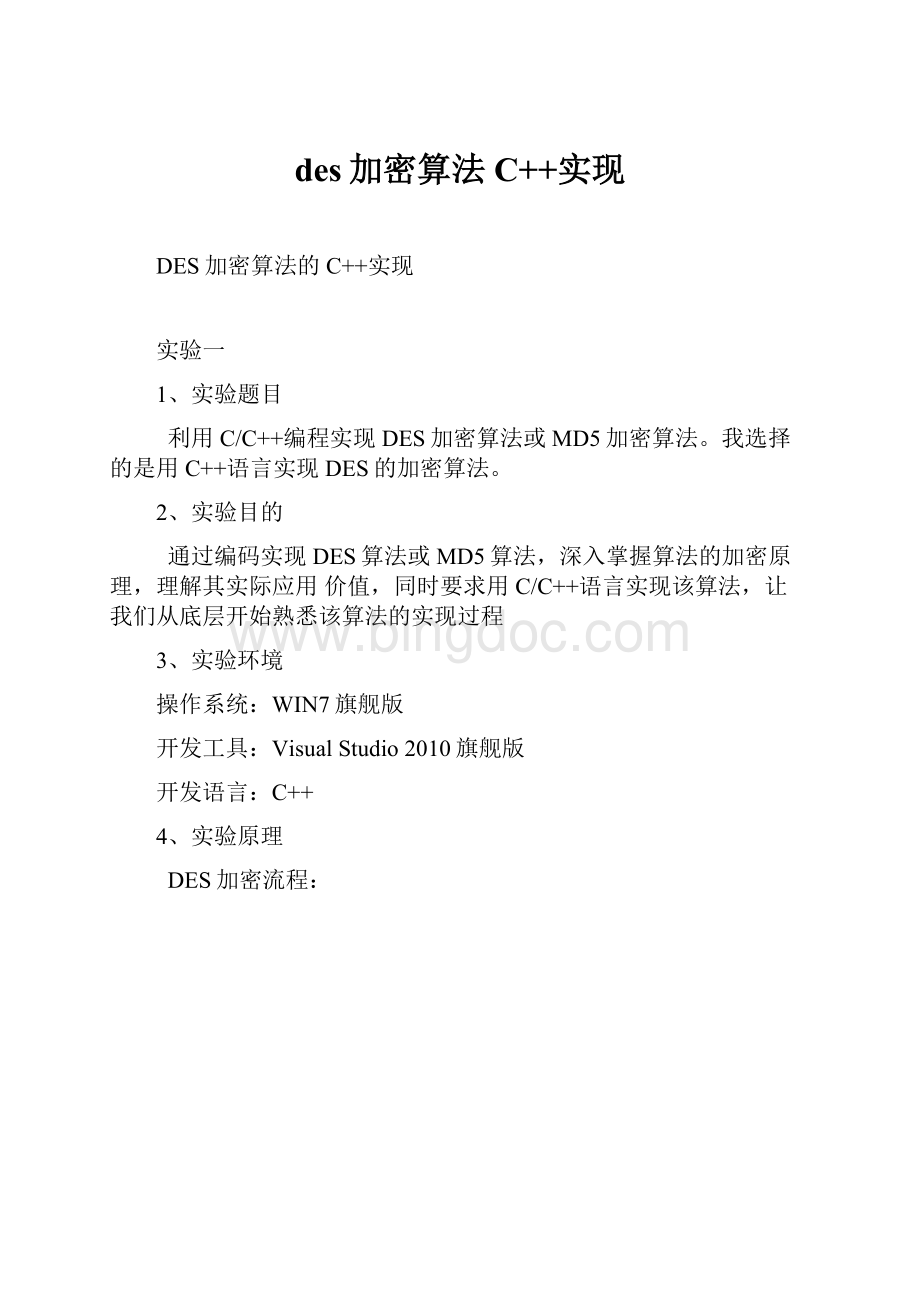des加密算法C++实现.docx
《des加密算法C++实现.docx》由会员分享,可在线阅读,更多相关《des加密算法C++实现.docx(32页珍藏版)》请在冰点文库上搜索。

des加密算法C++实现
DES加密算法的C++实现
实验一
1、实验题目
利用C/C++编程实现DES加密算法或MD5加密算法。
我选择的是用C++语言实现DES的加密算法。
2、实验目的
通过编码实现DES算法或MD5算法,深入掌握算法的加密原理,理解其实际应用价值,同时要求用C/C++语言实现该算法,让我们从底层开始熟悉该算法的实现过程
3、实验环境
操作系统:
WIN7旗舰版
开发工具:
VisualStudio2010旗舰版
开发语言:
C++
4、实验原理
DES加密流程:
如上图所示为DES的加密流程,其中主要包含初始置换,压缩换位1,压缩换位2,扩展置换,S盒置换,异或运算、终结置换等过程。
初始置换是按照初始置换表将64位明文重新排列次序
扩展置换是将原32为数据扩展为48位数据,它主要由三个目的:
1、产生与子密钥相同的长度
2、提供更长的结果,使其在加密过程中可以被压缩
3、产生雪崩效应,使得输入的一位将影响两个替换
S盒置换是DES算法中最核心的内容,在DES中,只有S盒置换是非线性的,它比DES中其他任何一步都提供更好的安全性
终结置换与初始置换相对应,它们都不影响DES的安全性,主要目的是为了更容易将明文与密文数据一字节大小放入DES的f算法中
DES解密流程与加密流程基本相同,只不过在进行16轮迭代元算时,将子密钥生成的K的次序倒过来进行迭代运算
5、实验过程记录
在对DES算法有了清晰的认识后,编码过程中我将其分为几个关键部分分别进行编码,最后将整个过程按顺序执行,即可完成DES的加密,代码的主要几个函数如下:
//Byte转为Bit
ByteToBit(ElemTypech,ElemTypebit[8])
//Bit转为Byte
BitToByte(ElemTypebit[8],ElemType&ch)
//初始置换
InitialEX(ElemTypeInorder[64],ElemTypeDisorder[64])
//终结置换
AntiEx(ElemTypeDisorder[64])
//扩展置换
ExpandEX(ElemTypeRightMsg[32],ElemTypeExpandMsg[48])
//16轮迭代加密
MoveLeft(ElemTypeC[28],ElemTypeD[28],ElemTypeL0[32],ElemTypeR0[32])
//16轮迭代解密
mMoveLeft(ElemTypeC[28],ElemTypeD[28],ElemTypeL0[32],ElemTypeR0[32])
//生成48位子密钥
GetCD48(ElemTypeC[28],ElemTypeD[28],ElemTypeSecret[48])
//48位明文与子密钥进行异或运算
XOR(ElemTypeExpandMsg[48],ElemTypeSecret[48],ElemTypeResult[48])
//S盒四位输出
getSOut(ElemTypeResult[48],ElemTypeSout[32])
//直接置换
DirExchange(ElemTypeSout[32],ElemTypeDirOut[32])
//Li与Ri进行抑或运算
XORLR(ElemTypeDirOut[32],ElemTypeLeft[32],ElemTypeResult[32])
函数执行次序和调用关系关系如下:
6、实验结果
1、根据提示,输入任意8字节的原文,并将其转换为64为二进制明文:
2、将64为二进制明文进行初始置换:
3、将原64位明文分成左右两半,并对右半边进行扩展置换:
4依次获得子密钥。
按上述流程完成16轮迭代运算后进行终结置换,得到64位密文(整个过程设计数据过多,没有一一输出,只给出最终截图内容)
5、按1开始进行解密,流程与加密相同,中间过程省去,只给出最终结果:
7、实验总结
通过完成本实验,我详细了解了DES算法的实现过程和工作原理,相比较在课堂上学到的理论知识,我认为通过实践后掌握的更加深刻。
在课堂上我们学习DES算法,很多都是基于理论上的知识,但并没有真正的使用过DES,而通过编码实现DES,我们更好地理解了该怎么用DES去解决实际问题,这对我们以后的学习是很有帮助的,掌握了DES的算法实现后,我们在以后写到相关程序时可以快速的将其利用,使其真正的为我们服务。
8、源代码(见附录)
附录(DES源代码)
//DES.cpp:
定义控制台应用程序的入口点。
//
#include"stdafx.h"
#include"function.h"
#include
#include
#include
usingnamespacestd;
//置换矩阵
intIP_EX[64]=
{
58,50,42,34,26,18,10,2,
60,52,44,36,28,20,12,4,
62,54,46,38,30,22,14,6,
64,56,48,40,32,24,16,8,
57,49,41,33,25,17,9,1,
59,51,43,35,27,19,11,3,
61,53,45,37,29,21,13,5,
63,55,47,39,31,23,15,7
};
//逆置换矩阵
intIP_ANTEX[64]=
{
40,8,48,16,56,24,64,32,
39,7,47,15,55,23,63,31,
38,6,46,14,54,22,62,30,
37,5,45,13,53,21,61,29,
36,4,44,12,52,20,60,28,
35,3,43,11,51,19,59,27,
34,2,41,10,50,18,58,26,
33,1,41,9,49,17,57,25
};
//扩展矩阵
intEXTEND[48]=
{
32,1,2,3,4,5,
4,5,6,7,8,9,
8,9,10,11,12,13,
12,13,14,15,16,17,
16,17,18,19,20,21,
20,21,22,23,24,25,
24,25,26,27,28,29,
28,29,30,31,1,2
};
//S盒
intS[8][4][16]=
{
{
{14,4,13,1,2,15,11,8,3,10,6,12,5,9,0,7},
{0,15,7,4,14,2,13,1,10,6,12,11,9,5,3,8},
{4,1,14,8,13,6,2,11,15,12,9,7,3,10,5,0},
{15,12,8,2,4,9,1,7,5,11,3,14,10,0,6,13}
},
{
{15,1,8,14,6,11,3,4,9,7,2,13,12,0,5,10},
{3,13,4,7,15,2,8,14,12,0,1,10,6,9,11,5},
{0,14,7,11,10,4,13,1,5,8,12,6,9,3,2,15},
{13,8,10,1,3,15,4,2,11,6,7,12,0,5,14,9}
},
{
{10,0,9,14,6,3,15,5,1,13,12,7,11,4,2,8},
{13,7,0,9,3,4,6,10,2,8,5,14,12,11,15,1},
{13,6,4,9,8,15,3,0,11,1,2,12,5,10,14,7},
{1,10,13,0,6,9,8,7,4,15,14,3,11,5,2,12}
},
{
{7,13,14,3,0,6,9,10,1,2,8,5,11,12,4,15},
{13,8,11,5,6,15,0,3,4,7,2,12,1,10,14,9},
{10,6,9,0,12,11,7,13,15,1,3,14,5,2,8,4},
{3,15,0,6,10,1,13,8,9,4,5,11,12,7,2,14}
},
{
{2,12,4,1,7,10,11,6,8,5,3,15,13,0,14,9},
{14,11,2,12,4,7,13,1,5,0,15,10,3,9,8,6},
{4,2,1,11,10,13,7,8,15,9,12,5,6,3,0,14},
{11,8,12,7,1,14,2,13,6,15,0,9,10,4,5,3}
},
{
{12,1,10,15,9,2,6,8,0,13,3,4,14,7,5,11},
{10,15,4,2,7,12,9,5,6,1,13,14,0,11,3,8},
{9,14,15,5,2,8,12,3,7,0,4,10,1,13,11,6},
{4,3,2,12,9,5,15,10,11,14,1,7,6,0,8,13}
},
{
{4,11,2,14,15,0,8,13,3,12,9,7,5,10,6,1},
{13,0,11,7,4,9,1,10,14,3,5,12,2,15,8,6},
{1,4,11,13,12,3,7,14,10,15,6,8,0,5,9,2},
{6,11,13,8,1,4,10,7,9,5,0,15,14,2,3,12}
},
{
{13,2,8,4,6,15,11,1,10,9,3,14,5,0,12,7},
{1,15,13,8,10,3,7,4,12,5,6,11,0,14,9,2},
{7,11,4,1,9,12,14,2,0,6,10,13,15,3,5,8},
{2,1,14,7,4,10,8,13,15,12,9,0,3,5,6,11}
}
};
//直接置换
intDIREX[32]=
{
16,7,20,21,
29,12,28,17,
1,15,23,26,
5,18,31,10,
2,8,24,14,
32,27,3,9,
19,13,30,6,
22,11,4,25
};
//左移移位表
intMOVELEFT[16]=
{
1,1,2,2,2,2,2,2,
1,2,2,2,2,2,2,1
};
//压缩换位表2
intCutEX[48]=
{
14,17,11,24,1,5,
3,28,15,6,21,10,
23,19,12,4,26,8,
16,7,27,20,13,2,
41,52,31,37,47,55,
30,40,51,45,33,48,
44,49,39,56,34,53,
46,42,50,36,29,32
};
typedefcharElemType;
ElemTypesubsec[16][48];
//Byte转bit
intByteToBit(ElemTypech,ElemTypebit[8])
{
for(intindex=7;index>=0;index--)
{
bit[index]=(ch>>index)&1;
//cout<<(int)bit[index];
}
return0;
}
//bit转Byte
intBitToByte(ElemTypebit[8],ElemType&ch)
{
ElemTypetempch=0;
ElemTypetempbit[8];
for(inti=0;i<8;i++)
{
tempbit[i]=bit[i];
}
tempbit[7]=0;
for(intindex=7;index>=0;index--)
{
tempch=tempch|(tempbit[index]<<(index));
}
ch=tempch;
//cout<<(char)tempch<return0;
}
//bit64转换为Byte8
voidBit64ToByte8(ElemTypebit[64],ElemTypech[8])
{
ElemTypetempbit[8];
for(inti=0;i<8;i++)
{
for(intj=0;j<8;j++)
{
tempbit[7-j]=bit[i*8+j];
}
BitToByte(tempbit,ch[i]);
}
}
//划分为多少块
intStringBlock(stringmsg)
{
intMsgBlock=0;
if(msg.length()%8==0)
{
MsgBlock=msg.length()/8;
}
else
{
MsgBlock=msg.length()/8+1;
}
returnMsgBlock;
}
//按块取数据
voidDivideString(stringmsg,intBlockNum,ElemTypech[8])
{
intstart=(BlockNum-1)*8;
ElemTypech1[8]=
{
msg[start],msg[start+1],msg[start+2],msg[start+3],
msg[start+4],msg[start+5],msg[start+6],msg[start+7]
};
for(inti=0;i<8;i++)
{
ch[i]=ch1[i];
}
}
//按64位分一组
voidGet64Bit(ElemTypech[8],ElemTypebit[64])
{
ElemTypetemp[8];
intcount=0;
for(inti=0;i<8;i++)
{
ByteToBit(ch[i],temp);
for(intj=0;j<8;j++)
{
bit[count*8+j]=temp[7-j];
}
count++;
}
}
//初始置换
voidInitialEX(ElemTypeInorder[64],ElemTypeDisorder[64])
{
for(inti=0;i<64;i++)
{
Disorder[i]=Inorder[IP_EX[i]-1];
}
}
//逆置换
voidAntiEx(ElemTypeDisorder[64])
{
ElemTypetemp[64];
for(inti=0;i<64;i++)
{
temp[i]=Disorder[i];
}
for(inti=0;i<64;i++)
{
Disorder[i]=temp[IP_ANTEX[i]-1];
}
}
//扩展置换
voidExpandEX(ElemTypeRightMsg[32],ElemTypeExpandMsg[48])
{
for(inti=0;i<48;i++)
{
ExpandMsg[i]=RightMsg[EXTEND[i]-1];
}
}
//16轮加密迭代
voidMoveLeft(ElemTypeC[28],ElemTypeD[28],ElemTypeL0[32],ElemTypeR0[32])
{
ElemTypeSecret[48];//子密钥
ElemTypeResult[48];//每轮异或结果
ElemTypeSout[32];//每轮S盒输出
ElemTypeDirOut[32];//直接置换输出
ElemTypeRResult[32];
ElemTypeLResult[32];
ElemTypeExpandMsg[48];
ElemTypetemp[32];
for(inti=0;i<32;i++)
{
LResult[i]=L0[i];
RResult[i]=R0[i];
}
for(inti=0;i<16;i++)
{
if(MOVELEFT[i]==1)
{
for(intj=0;j<27;j++)
{
C[i]=C[i+1];
}
C[27]=0;
}
else
{
for(intj=0;j<26;j++)
{
C[i]=C[i+2];
}
C[26]=0;
C[27]=0;
}
ExpandEX(RResult,ExpandMsg);
GetCD48(C,D,Secret);
for(intj=0;j<48;j++)
{
subsec[15-i][j]=Secret[j];//获取界面的子密钥
}
XOR(ExpandMsg,Secret,Result);
//S盒置换
getSOut(Result,Sout);
//直接置换
DirExchange(Sout,DirOut);
//与L进行异或
XORLR(DirOut,LResult,temp);
for(inti=0;i<32;i++)
{
LResult[i]=RResult[i];
}
for(inti=0;i<32;i++)
{
RResult[i]=temp[i];
}
for(inti=0;i<32;i++)
{
L0[i]=LResult[i];
R0[i]=RResult[i];
}
}
/*cout<<"左边"<for(inti=0;i<32;i++)
{
cout<<(int)LResult[i];
if((i+1)%8==0)
{
cout<}
}
cout<<"右边"<for(inti=0;i<32;i++)
{
cout<<(int)RResult[i];
if((i+1)%8==0)
{
cout<}
}*/
}
//16轮解密迭代
voidmMoveLeft(ElemTypeC[28],ElemTypeD[28],ElemTypeL0[32],ElemTypeR0[32])
{
ElemTypeResult[48];//每轮异或结果
ElemTypeSout[32];//每轮S盒输出
ElemTypeDirOut[32];//直接置换输出
ElemTypeRResult[32];
ElemTypeLResult[32];
ElemTypeExpandMsg[48];
ElemTypetemp[32];
for(inti=0;i<32;i++)
{
LResult[i]=L0[i];
RResult[i]=R0[i];
}
for(inti=0;i<16;i++)
{
/*if(MOVELEFT[i]==1)
{
for(intj=0;j<27;j++)
{
C[i]=C[i+1];
}
C[27]=0;
}
else
{
for(intj=0;j<26;j++)
{
C[i]=C[i+2];
}
C[26]=0;
C[27]=0;
}*/
ExpandEX(RResult,ExpandMsg);//明文扩展
XOR(ExpandMsg,subsec[i],Result);//扩展明文与子密钥进行异或
getSOut(Result,Sout);//S盒置换
DirExchange(Sout,DirOut);//直接置换
XORLR(DirOut,LResult,temp);//与L进行异或
for(intj=0;j<32;j++)
{
LResult[j]=RResult[j];
}
for(intj=0;j<32;j++)
{
RResult[j]=temp[j];
}
}
for(inti=0;i<32;i++)
{
L0[i]=LResult[i];
R0[i]=RResult[i];
}
/*cout<<"左边"<for(inti=0;i<32;i++)
{
cout<<(int)LResult[i];
if((i+1)%8==0)
{
cout<}
}
cout<<"右边"<for(inti=0;i<32;i++)
{
cout<<(int)RResult[i];
if((i+1)%8=